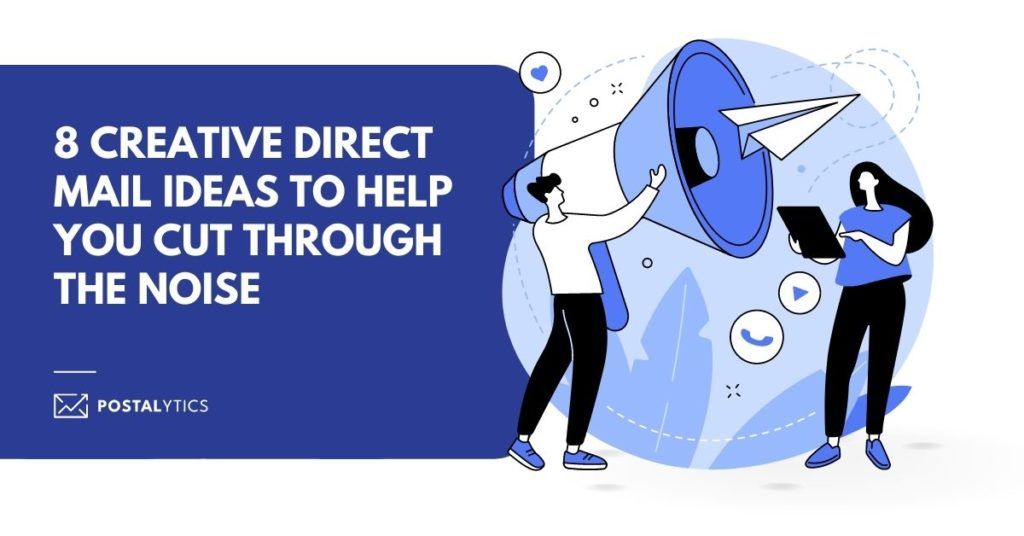
Are you looking for creative direct mail ideas that will help you blast past your targets in the next marketing campaign? If so, you’ve come to the right place. As the leading direct mail automation platform, we spend a lot of time looking into the best ways to optimize direct mail campaigns.
So, let’s explore why direct mail works and what creative ideas you can start using today.
Direct mail marketing breaks through the digital clutter, but exceptionally creative direct mail really stands out and gets attention. Marketers whose direct mail campaigns feature only simple letters and postcards can be hugely successful with creative approaches that don’t involve complex construction or expensive elements.
Here are the creative direct mail ideas you can use to break out of traditional thinking to generate more leads and connect with more customers. Use these direct mail marketing ideas to generate a greater impact and distinguish your company’s message from the vast majority of uninspired promotions that consumers typically find in their mailboxes.
What We’ll Cover
- #1 Humor in direct mail marketing
- #2 Timing of your direct mail campaign
- #3 Value of your direct mail campaign
- #4 Personalization in direct mail marketing
- #5 Colors of your direct mail campaign
- #6 Enticing headlines in direct mail marketing
- #7 Storytelling & direct mail marketing
- #8 Postscripts in direct mail marketing
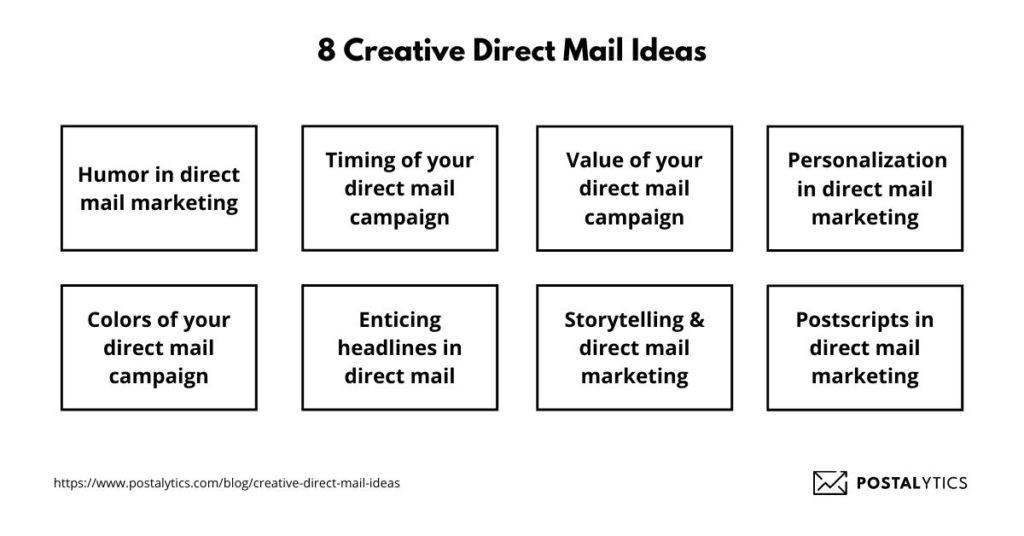
#1 Humor in direct mail marketing
Marketers have long employed humorous ads to attract and keep consumer attention.
When it connects, funny messages can be a very successful part of your marketing campaign. Think of all those Super Bowl ads you can recall. It’s likely that most of those memorable commercials used humor to associate their brands with an enjoyable feeling.
Humorous ads are more likely to be shared. They make the advertiser seem more friendly and relatable. People who receive a funny postcard will often save it and show it to others. You get bonus distribution for free!
Comedy in direct mail can take many forms. You might use an amusing image, a surprising product claim, or a good-natured competitor comparison. The real payoff is associating humor with your product or service. This is where a smile or laugh makes people think positively about a brand.
Of course, humor has potential downsides. What is funny to some can be off-putting to others. Be careful not to offend anyone and always test a small audience before launching a widespread campaign featuring humor. Be prepared to change your humorous direct mail if current events make people unlikely to be receptive to funny messages. Sending amusing postcards to customers recovering from a recent devastating hurricane, for example, probably won’t be appreciated. The timing is wrong.
Humor isn’t for every brand. If your brand is known for being deadly serious and buttoned up, customers could see an attempt at humor as forced and out of context. Otherwise, don’t pass up the opportunity to explore being a little bit funny.
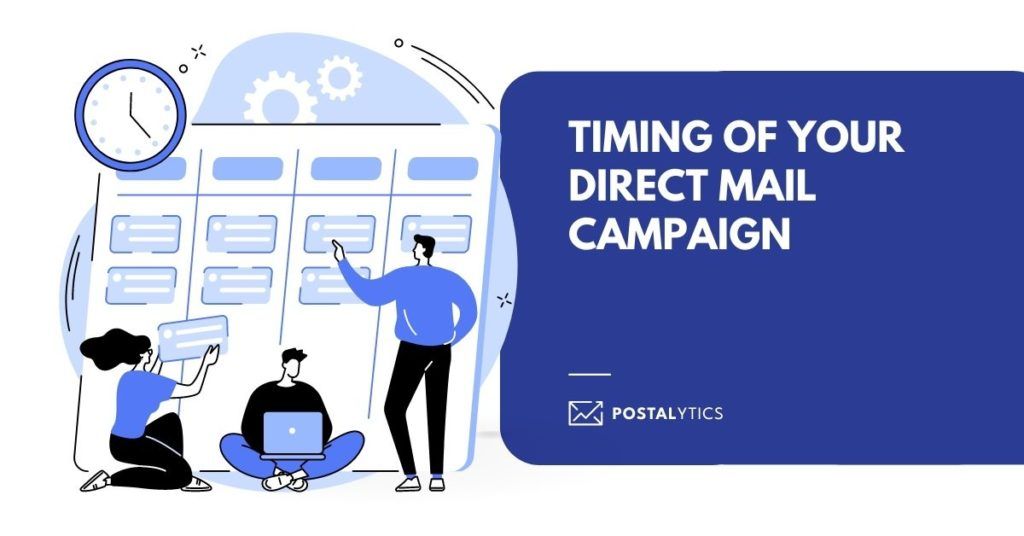
#2 Timing of your direct mail campaign
Connecting a direct mail message to a customer-specific circumstance can make your company look like mind-readers without being creepy. We all know that the success of your marketing strategy depends on sending the right people the right offer at the right time. You can accomplish this feat by linking Postalytics to your CRM or other data sources.
Here are some ways you might use triggered direct mail:
- Inactive customers may need a nudge to re-engage, and direct mail is the way to do it. Set alerts in your CRM system to notice when a customer has opened none of the last six emails you sent them. If the emails didn’t bounce, they might have stopped using the email address you have on file. Postal mail provides another way to reach them.
- Marketers frequently reach customers who place items in an online shopping cart but don’t check out to abandoned cart emails and re-targeting ads they see (or ignore) online. Consumers will notice when a postcard featuring a discount on items for which they were recently shopping shows up in their mailbox.
- If your business offers discounts to seniors, send notices and special offers to your customers shortly after their 65th birthday. Encourage them to register for senior programs or learn more about benefits now available to them. A specialized offer directed to only qualified buyers generates a better ROI for your mailing efforts at much lower costs.
#3 Value of your direct mail campaign
Providing something of value doesn’t mean you have to mail a physical item. Marketers have been using coupons or online promotional codes for a long time for a good reason– because it’s good marketing!
Some products or services have long sales cycles or are not appropriate for coupons. Providing value throughout the buyer’s journey is important, and with the internet, it’s easy. Give people QR codes to download a checklist, a buyer’s guide, games, contests, or a video, for example. You might even experiment with augmented reality. Features like these keep customers engaged with your brand until they are ready to buy. They also transform prospects into loyal customers and raving representatives of your business.
Do not neglect this powerful technique. Avoid the “Call us for more information” plea that everyone knows will subject them to a sales pitch. Find something of value to offer—every time.
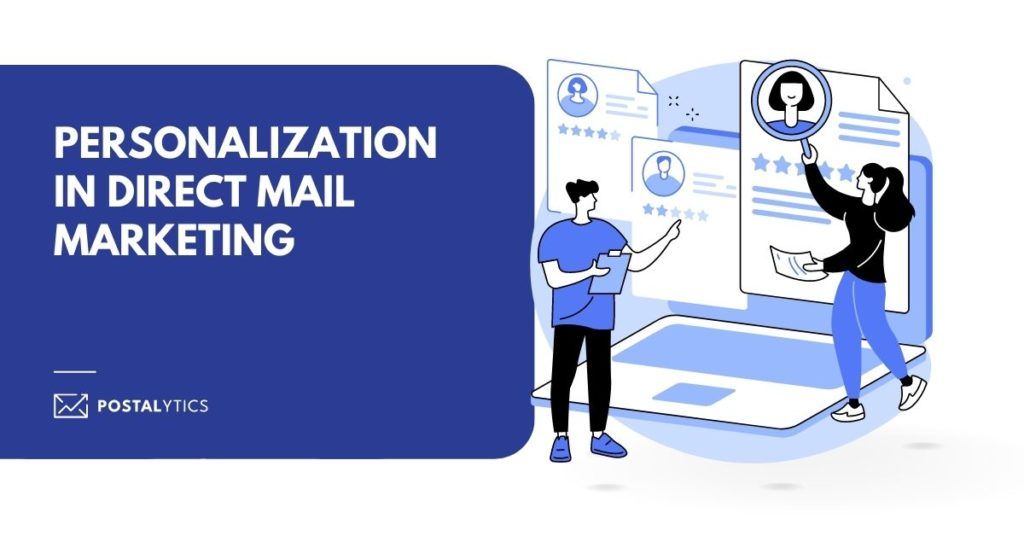
#4 Personalization in direct mail marketing
In the old days of direct mail, personalizing the content was difficult, limited, and expensive. High-quality digital printing has changed all that. Simple personalization using information already in your files can boost the response and conversion rates on your direct mail campaigns. Personalization may include items such as the customer’s name, references to the longevity of their relationship with your organization, past purchases or donations, or other easily acquired data from your own databases.
Direct mail recipients view personalized materials as a recognition of their importance as individuals.
Some personalization is explicit, such as inserting a customer’s name, account number, make and model of their car, or birthday into the text of a letter or postcard. In other cases, personalization is not so obvious. You may alter the photos you use on your postcard, for instance, based on factors such as age, gender, or race of the recipients. Here are some other ways you might connect with customers via direct mail personalization:
- Geography – Use different photos for customers who live in Colorado vs. customers in Florida, for example.
- Maps – Use maps in your direct mail to direct customers to the retail store, branch, or office nearest to them.
- Product – Your direct mail may include a photo or image of the product they last purchased from you or discounts on accessories specific to the product they bought.
- Previous Activity – Refer to a customer’s last service date, estimated car mileage, historical donation amounts, etc. to make it clear your communication was meant for only one person.
#5 Colors of your direct mail campaign
Bold, bright colors attract attention. This is especially true for direct mail postcards. Make your mail pieces stand out by designing them to include colors that attract attention.
Some colors are connected with certain emotions. Effective marketing campaigns take advantage of associating their companies with different colors. Many financial services companies, for example, make use of the colors green and blue because people associate the colors with money and trustworthiness.
- Red – Passion, energy, anger, danger
- Orange – Optimism, warmth, creativity
- Yellow – Happiness, positivity, inspiration
- Green – Prosperity, generosity, hope
- Turquoise – Compassion, calmness, peace
- Blue – Trust, loyalty, reliability
- Purple – Spirituality, imagination, wisdom
- Pink – Love, femininity, romance
- Brown – Stability, grounded, predictable
- Black – Elegance, strength, formality
- Gray – Control, practicality, maturity
- White – Purity, goodness, hope
Your company should establish a color pallet. If you stick with your preferred colors across all communication channels, buyers will recognize the message as coming from your organization. But don’t be afraid to shake things up by using an unusual color that stands out from the background.
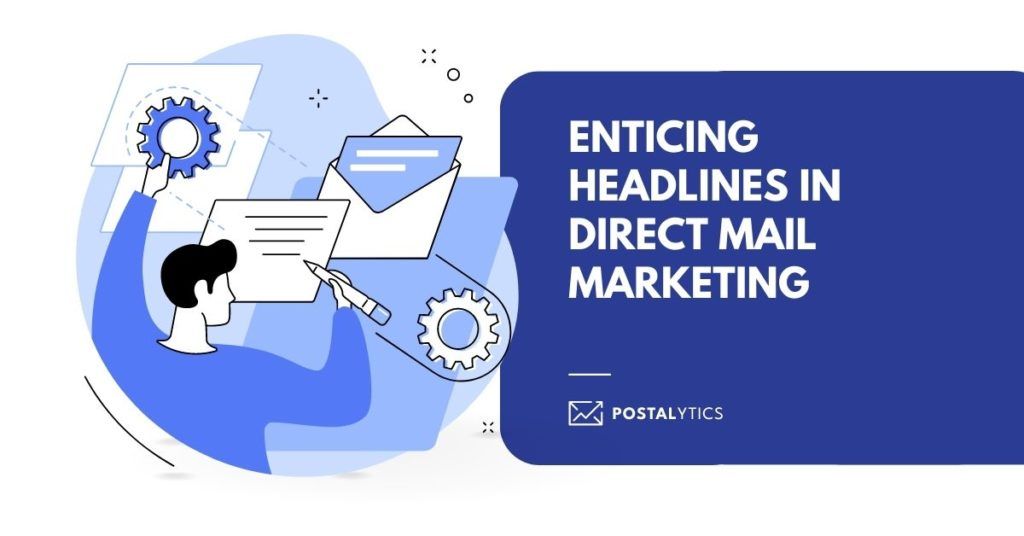
#6 Enticing headlines in direct mail marketing
Your prospects will notice the headlines in your letters and postcards. Make sure the material grabs their attention, or mail recipients may decide to read no further. Use questions or surprising/provocative statements in your headlines and spend some time developing them. Test different headlines to see which works best for your current and new audience.
With no spam filters that keep your messages from reaching the addressees, you can use any words you want, including “Free,” which always attracts attention.
The job of the headline in direct mail differs from headlines in journalism. Headlines should be 100% focused on getting prospects to read further.
#7 Storytelling & direct mail marketing
People love stories. Human brains are wired to respond to good stories, and readers remember them. Some organizations, such as non-profits, use stories effectively to cause readers to feel the emotion and make donations. Making an emotional connection is critical for the success of a charity fundraising campaign.
Stories work well in letter format, particularly when they include some illustrations, but you can use stories on postcards as well. Just begin to tell a story on the postcard and provide a website address or QR code leading to a page on the internet where prospects can read the rest. You can also link to an audio recording or video that tells a story.
Stories in direct mail are not sales pitches. Avoid blatant references to product features and benefits. The purpose of the story is to invoke an emotional response. The selling comes later. You can even tell a story with pictures.
Stories in direct mail can be inspirational. The message of the story should be consistent with your brand. You might use a story to highlight an aspect of your company culture, for instance, but it can’t be self-serving. Customers will see through such attempts immediately.
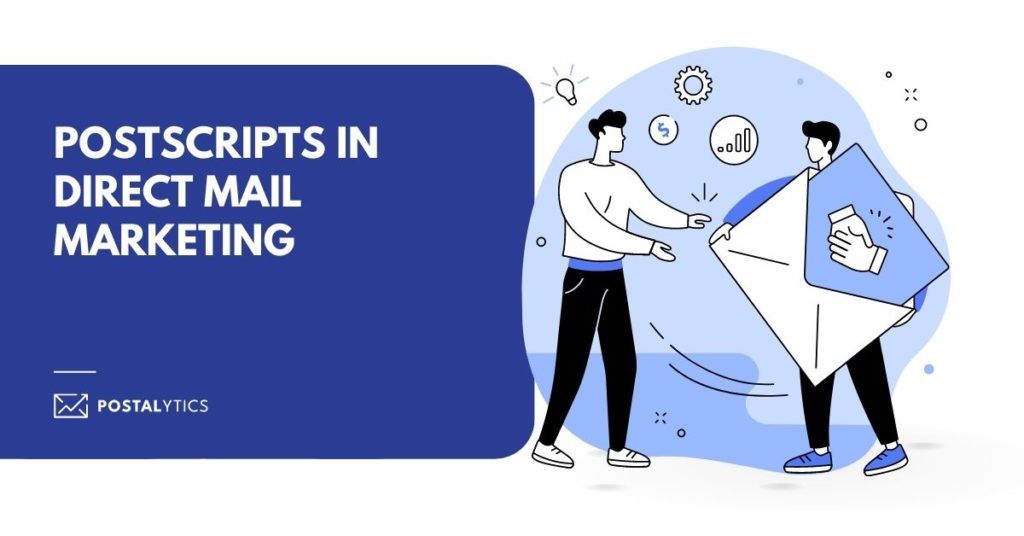
#8 Postscripts in direct mail marketing
Some letter-readers skip immediately to the postscript, so don’t miss this opportunity to get your message across in a concise and easily understood manner. The PS. in your letter should expose an important key point not already mentioned. Don’t simply repeat the offer. The postscript is in a unique place, and it stands out. Don’t waste this prime location on a weak message.
The postscript is a great place to emphasize urgency, such as a limited-time offer. It’s also an ideal opportunity to add personalization. Since it comes right below the letter signature, a personalized PS seems like an intimate conversation between the letter-writer and the recipient.
Direct mail marketing is more effective than any digital marketing channel. It pays to spend time to design creative direct mail pieces that boost the ROI of mail. Make an impression and generate messages people will remember and act upon when they make their buying decisions.
About the Author

Dennis Kelly
Dennis Kelly is CEO and co-founder of Postalytics. Dennis joined Boingnet, the predecessor to Postalytics, in 2013. Boingnet was focused on providing print and direct mail marketing service providers the ability to add digital marketing channels to their direct mail campaigns. Postalytics is Dennis’ 6th startup. He has been involved in starting and growing early-stage technology ventures for over 30 years and has held senior management roles at a diverse set of large technology firms including Computer Associates, Palm Inc. and Achieve Healthcare Information Systems.
